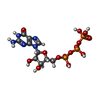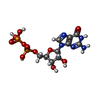+ Open data
Open data
- Basic information
Basic information
| Entry | Database: PDB / ID: 9nw3 | ||||||||||||||||||||||||
|---|---|---|---|---|---|---|---|---|---|---|---|---|---|---|---|---|---|---|---|---|---|---|---|---|---|
| Title | Ciliary tip central pair | ||||||||||||||||||||||||
 Components Components |
| ||||||||||||||||||||||||
 Keywords Keywords | PROTEIN BINDING / cilia / microtubules / central pair | ||||||||||||||||||||||||
| Function / homology |  Function and homology information Function and homology informationactomyosin structure organization / motile cilium / regulation of cytoskeleton organization / axoneme / microtubule-based process / structural constituent of cytoskeleton / microtubule binding / Hydrolases; Acting on acid anhydrides; Acting on GTP to facilitate cellular and subcellular movement / microtubule / cytoskeleton ...actomyosin structure organization / motile cilium / regulation of cytoskeleton organization / axoneme / microtubule-based process / structural constituent of cytoskeleton / microtubule binding / Hydrolases; Acting on acid anhydrides; Acting on GTP to facilitate cellular and subcellular movement / microtubule / cytoskeleton / hydrolase activity / GTPase activity / GTP binding / metal ion binding / nucleus / cytoplasm Similarity search - Function | ||||||||||||||||||||||||
| Biological species |  Tetrahymena thermophila CU428 (eukaryote) Tetrahymena thermophila CU428 (eukaryote) | ||||||||||||||||||||||||
| Method | ELECTRON MICROSCOPY / single particle reconstruction / cryo EM / Resolution: 3.7 Å | ||||||||||||||||||||||||
 Authors Authors | Legal, T.L. / Bui, K.H. | ||||||||||||||||||||||||
| Funding support |  Canada, 2items Canada, 2items
| ||||||||||||||||||||||||
 Citation Citation |  Journal: Curr Biol / Year: 2025 Journal: Curr Biol / Year: 2025Title: Structure of the ciliary tip central pair reveals the unique role of the microtubule-seam binding protein SPEF1. Authors: Thibault Legal / Ewa Joachimiak / Mireya Parra / Wang Peng / Amanda Tam / Corbin Black / Mayukh Guha / Chau Anh Nguyen / Avrin Ghanaeian / Melissa Valente-Paterno / Gary Brouhard / Jacek ...Authors: Thibault Legal / Ewa Joachimiak / Mireya Parra / Wang Peng / Amanda Tam / Corbin Black / Mayukh Guha / Chau Anh Nguyen / Avrin Ghanaeian / Melissa Valente-Paterno / Gary Brouhard / Jacek Gaertig / Dorota Wloga / Khanh Huy Bui /    Abstract: Motile cilia are unique organelles with the ability to move autonomously. The force generated by beating cilia propels cells and moves fluids. The ciliary skeleton is made of peripheral doublet ...Motile cilia are unique organelles with the ability to move autonomously. The force generated by beating cilia propels cells and moves fluids. The ciliary skeleton is made of peripheral doublet microtubules and a central pair (CP) with a distinct structure at the tip. In this study, we present a high-resolution structure of the CP in the ciliary tip of the ciliate Tetrahymena thermophila and identify several tip proteins that bind and form unique patterns on both microtubules of the tip CP. Two of those proteins that contain tubulin polymerization-promoting protein (TPPP)-like domains, TLP1 and TLP2, bind to high curvature regions of the microtubule. TLP2, which contains two TPPP-like domains, is an unusually long protein that wraps laterally around half a microtubule and forms the bridge between the two microtubules. Moreover, we found that the conserved protein SPEF1 binds to both microtubule seams and crosslinked the two microtubules. In vitro, human SPEF1 binds to the microtubule seam as visualized by cryoelectron tomography and subtomogram averaging. Single-molecule microtubule dynamics assays indicate that SPEF1 stabilizes microtubules in vitro. Together, these data show that the proteins in the tip CP maintain stable microtubule structures and play important roles in maintaining the integrity of the axoneme. | ||||||||||||||||||||||||
| History |
|
- Structure visualization
Structure visualization
| Structure viewer | Molecule:  Molmil Molmil Jmol/JSmol Jmol/JSmol |
|---|
- Downloads & links
Downloads & links
- Download
Download
| PDBx/mmCIF format |  9nw3.cif.gz 9nw3.cif.gz | 6.8 MB | Display |  PDBx/mmCIF format PDBx/mmCIF format |
|---|---|---|---|---|
| PDB format |  pdb9nw3.ent.gz pdb9nw3.ent.gz | Display |  PDB format PDB format | |
| PDBx/mmJSON format |  9nw3.json.gz 9nw3.json.gz | Tree view |  PDBx/mmJSON format PDBx/mmJSON format | |
| Others |  Other downloads Other downloads |
-Validation report
| Summary document |  9nw3_validation.pdf.gz 9nw3_validation.pdf.gz | 7.2 MB | Display |  wwPDB validaton report wwPDB validaton report |
|---|---|---|---|---|
| Full document |  9nw3_full_validation.pdf.gz 9nw3_full_validation.pdf.gz | 8.6 MB | Display | |
| Data in XML |  9nw3_validation.xml.gz 9nw3_validation.xml.gz | 1.2 MB | Display | |
| Data in CIF |  9nw3_validation.cif.gz 9nw3_validation.cif.gz | 1.7 MB | Display | |
| Arichive directory |  https://data.pdbj.org/pub/pdb/validation_reports/nw/9nw3 https://data.pdbj.org/pub/pdb/validation_reports/nw/9nw3 ftp://data.pdbj.org/pub/pdb/validation_reports/nw/9nw3 ftp://data.pdbj.org/pub/pdb/validation_reports/nw/9nw3 | HTTPS FTP |
-Related structure data
| Related structure data |  49872MC  9ntmC  9ot2C M: map data used to model this data C: citing same article ( |
|---|---|
| Similar structure data | Similarity search - Function & homology  F&H Search F&H Search |
- Links
Links
- Assembly
Assembly
| Deposited unit | 
|
|---|---|
| 1 |
|
- Components
Components
-Protein , 9 types, 103 molecules AAACAEBABCBECACCCEDADCDEEAECEEFAFCFEGAGCGEHAHCHEIAICIEJAJCJE...
| #1: Protein | Mass: 49639.035 Da / Num. of mol.: 39 / Source method: isolated from a natural source / Source: (natural)  Tetrahymena thermophila CU428 (eukaryote) Tetrahymena thermophila CU428 (eukaryote)References: UniProt: P41351, Hydrolases; Acting on acid anhydrides; Acting on GTP to facilitate cellular and subcellular movement #2: Protein | Mass: 49617.676 Da / Num. of mol.: 39 / Source method: isolated from a natural source / Source: (natural)  Tetrahymena thermophila CU428 (eukaryote) / References: UniProt: P41352 Tetrahymena thermophila CU428 (eukaryote) / References: UniProt: P41352#3: Protein | Mass: 24702.463 Da / Num. of mol.: 3 / Source method: isolated from a natural source / Source: (natural)  Tetrahymena thermophila CU428 (eukaryote) / References: UniProt: Q22DM0 Tetrahymena thermophila CU428 (eukaryote) / References: UniProt: Q22DM0#4: Protein | Mass: 88103.156 Da / Num. of mol.: 3 / Source method: isolated from a natural source / Source: (natural)  Tetrahymena thermophila CU428 (eukaryote) / References: UniProt: I7M0H4 Tetrahymena thermophila CU428 (eukaryote) / References: UniProt: I7M0H4#5: Protein | Mass: 57465.531 Da / Num. of mol.: 3 / Source method: isolated from a natural source / Source: (natural)  Tetrahymena thermophila CU428 (eukaryote) / References: UniProt: Q246A0 Tetrahymena thermophila CU428 (eukaryote) / References: UniProt: Q246A0#6: Protein | Mass: 37998.410 Da / Num. of mol.: 4 / Source method: isolated from a natural source / Source: (natural)  Tetrahymena thermophila CU428 (eukaryote) / References: UniProt: I7M5Z8 Tetrahymena thermophila CU428 (eukaryote) / References: UniProt: I7M5Z8#7: Protein | Mass: 205367.016 Da / Num. of mol.: 3 / Source method: isolated from a natural source / Source: (natural)  Tetrahymena thermophila CU428 (eukaryote) / References: UniProt: I7MHP2 Tetrahymena thermophila CU428 (eukaryote) / References: UniProt: I7MHP2#8: Protein | Mass: 39902.203 Da / Num. of mol.: 3 / Source method: isolated from a natural source / Source: (natural)  Tetrahymena thermophila CU428 (eukaryote) / References: UniProt: W7X235 Tetrahymena thermophila CU428 (eukaryote) / References: UniProt: W7X235#9: Protein | Mass: 11293.362 Da / Num. of mol.: 6 / Source method: isolated from a natural source / Source: (natural)  Tetrahymena thermophila CU428 (eukaryote) / References: UniProt: Q22W95 Tetrahymena thermophila CU428 (eukaryote) / References: UniProt: Q22W95 |
|---|
-Protein/peptide , 1 types, 27 molecules 8A8B8C8D8E8F8G8H8I8J8K8L8M8N8O8P8Q8R8S8T8U8V8W8X8Y8Z9A
| #10: Protein/peptide | Mass: 3252.000 Da / Num. of mol.: 27 / Source method: isolated from a natural source / Source: (natural)  Tetrahymena thermophila CU428 (eukaryote) Tetrahymena thermophila CU428 (eukaryote) |
|---|
-Non-polymers , 3 types, 117 molecules 




| #11: Chemical | ChemComp-GTP / #12: Chemical | ChemComp-MG / #13: Chemical | ChemComp-GDP / |
|---|
-Details
| Has ligand of interest | N |
|---|---|
| Has protein modification | Y |
-Experimental details
-Experiment
| Experiment | Method: ELECTRON MICROSCOPY |
|---|---|
| EM experiment | Aggregation state: FILAMENT / 3D reconstruction method: single particle reconstruction |
- Sample preparation
Sample preparation
| Component | Name: Ciliary tip central pair / Type: ORGANELLE OR CELLULAR COMPONENT / Entity ID: #1-#10 / Source: NATURAL |
|---|---|
| Source (natural) | Organism:  Tetrahymena thermophila CU428 (eukaryote) Tetrahymena thermophila CU428 (eukaryote) |
| Buffer solution | pH: 7.4 |
| Specimen | Embedding applied: NO / Shadowing applied: NO / Staining applied: NO / Vitrification applied: YES |
| Vitrification | Cryogen name: ETHANE |
- Electron microscopy imaging
Electron microscopy imaging
| Experimental equipment |  Model: Titan Krios / Image courtesy: FEI Company |
|---|---|
| Microscopy | Model: TFS KRIOS |
| Electron gun | Electron source:  FIELD EMISSION GUN / Accelerating voltage: 300 kV / Illumination mode: FLOOD BEAM FIELD EMISSION GUN / Accelerating voltage: 300 kV / Illumination mode: FLOOD BEAM |
| Electron lens | Mode: BRIGHT FIELD / Nominal defocus max: 3000 nm / Nominal defocus min: 1000 nm |
| Image recording | Electron dose: 45 e/Å2 / Film or detector model: GATAN K3 (6k x 4k) |
- Processing
Processing
| CTF correction | Type: PHASE FLIPPING AND AMPLITUDE CORRECTION |
|---|---|
| 3D reconstruction | Resolution: 3.7 Å / Resolution method: FSC 0.143 CUT-OFF / Num. of particles: 66174 / Symmetry type: POINT |
 Movie
Movie Controller
Controller























 PDBj
PDBj








